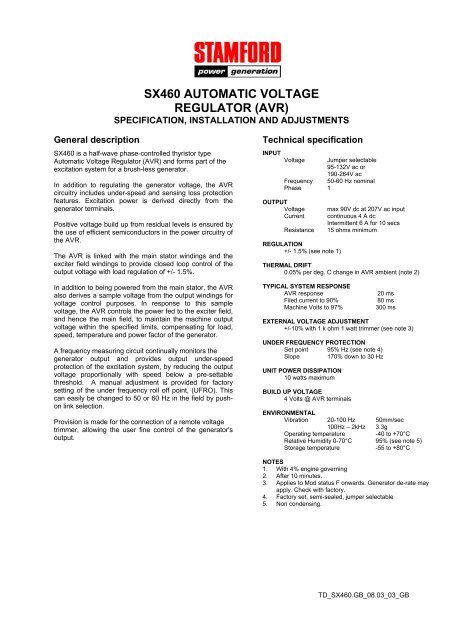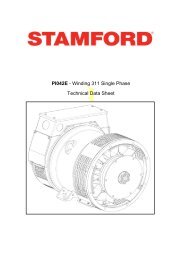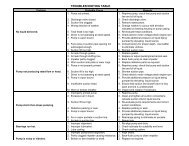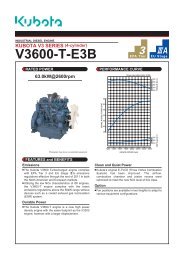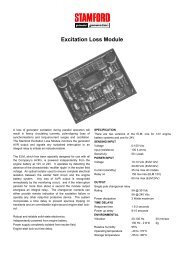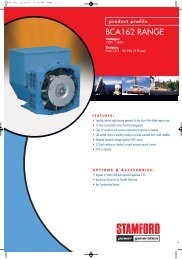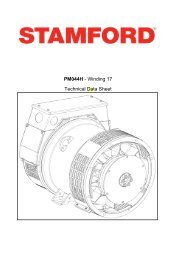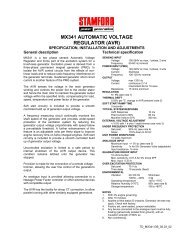sx460 automatic voltage regulator (avr) - Frontier Power Products
sx460 automatic voltage regulator (avr) - Frontier Power Products
sx460 automatic voltage regulator (avr) - Frontier Power Products
You also want an ePaper? Increase the reach of your titles
YUMPU automatically turns print PDFs into web optimized ePapers that Google loves.
SX460 AUTOMATIC VOLTAGE<br />
REGULATOR (AVR)<br />
SPECIFICATION, INSTALLATION AND ADJUSTMENTS<br />
General description<br />
SX460 is a half-wave phase-controlled thyristor type<br />
Automatic Voltage Regulator (AVR) and forms part of the<br />
excitation system for a brush-less generator.<br />
In addition to regulating the generator <strong>voltage</strong>, the AVR<br />
circuitry includes under-speed and sensing loss protection<br />
features. Excitation power is derived directly from the<br />
generator terminals.<br />
Positive <strong>voltage</strong> build up from residual levels is ensured by<br />
the use of efficient semiconductors in the power circuitry of<br />
the AVR.<br />
The AVR is linked with the main stator windings and the<br />
exciter field windings to provide closed loop control of the<br />
output <strong>voltage</strong> with load regulation of +/- 1.5%.<br />
In addition to being powered from the main stator, the AVR<br />
also derives a sample <strong>voltage</strong> from the output windings for<br />
<strong>voltage</strong> control purposes. In response to this sample<br />
<strong>voltage</strong>, the AVR controls the power fed to the exciter field,<br />
and hence the main field, to maintain the machine output<br />
<strong>voltage</strong> within the specified limits, compensating for load,<br />
speed, temperature and power factor of the generator.<br />
A frequency measuring circuit continually monitors the<br />
generator output and provides output under-speed<br />
protection of the excitation system, by reducing the output<br />
<strong>voltage</strong> proportionally with speed below a pre-settable<br />
threshold. A manual adjustment is provided for factory<br />
setting of the under frequency roll off point, (UFRO). This<br />
can easily be changed to 50 or 60 Hz in the field by pushon<br />
link selection.<br />
Provision is made for the connection of a remote <strong>voltage</strong><br />
trimmer, allowing the user fine control of the generator's<br />
output.<br />
Technical specification<br />
INPUT<br />
Voltage<br />
Frequency<br />
Phase 1<br />
OUTPUT<br />
Voltage<br />
Current<br />
Resistance<br />
REGULATION<br />
+/- 1.5% (see note 1)<br />
Jumper selectable<br />
95-132V ac or<br />
190-264V ac<br />
50-60 Hz nominal<br />
max 90V dc at 207V ac input<br />
continuous 4 A dc<br />
Intermittent 6 A for 10 secs<br />
15 ohms minimum<br />
THERMAL DRIFT<br />
0.05% per deg. C change in AVR ambient (note 2)<br />
TYPICAL SYSTEM RESPONSE<br />
AVR response<br />
Filed current to 90%<br />
Machine Volts to 97%<br />
20 ms<br />
80 ms<br />
300 ms<br />
EXTERNAL VOLTAGE ADJUSTMENT<br />
+/-10% with 1 k ohm 1 watt trimmer (see note 3)<br />
UNDER FREQUENCY PROTECTION<br />
Set point 95% Hz (see note 4)<br />
Slope 170% down to 30 Hz<br />
UNIT POWER DISSIPATION<br />
10 watts maximum<br />
BUILD UP VOLTAGE<br />
4 Volts @ AVR terminals<br />
ENVIRONMENTAL<br />
Vibration 20-100 Hz 50mm/sec<br />
100Hz – 2kHz 3.3g<br />
Operating temperature<br />
-40 to +70°C<br />
Relative Humidity 0-70°C 95% (see note 5)<br />
Storage temperature<br />
-55 to +80°C<br />
NOTES<br />
1. With 4% engine governing<br />
2. After 10 minutes.<br />
3. Applies to Mod status F onwards. Generator de-rate may<br />
apply. Check with factory.<br />
4. Factory set, semi-sealed, jumper selectable<br />
5. Non condensing.<br />
TD_SX460.GB_08.03_03_GB
DESIGN DETAIL<br />
Generator<br />
Suppression<br />
Low Hz<br />
Detection<br />
Synchronising<br />
Ciruit<br />
Low Pass<br />
Filter<br />
Voltage<br />
Sensing<br />
Reference<br />
Voltage<br />
<strong>Power</strong><br />
supply<br />
Potential<br />
Divider &<br />
Rectifier<br />
Amp<br />
Ramp<br />
Generator<br />
Level<br />
Detector &<br />
Driver<br />
<strong>Power</strong><br />
Control<br />
Devices<br />
Hand<br />
Trimmer<br />
Stability<br />
Circuit<br />
Exciter<br />
Field<br />
The main functions of the AVR are:<br />
Potential Divider and Rectifier takes a proportion of the<br />
generator output <strong>voltage</strong> and attenuates it. This input chain<br />
of resistors includes the range potentiometer and hand<br />
trimmer which adjust the generator <strong>voltage</strong>. A rectifier<br />
converts the a.c. into d.c. for further processing.<br />
The Amplifier (Amp) compares the sensing <strong>voltage</strong> to the<br />
Reference Voltage and amplifies the difference (error) to<br />
provide a controlling signal for the power devices. The<br />
Ramp Generator and Level Detector and Driver infinitely<br />
control the conduction period of the <strong>Power</strong> Control Devices<br />
and hence provides the excitation system with the required<br />
power to maintain the generator <strong>voltage</strong> within specified<br />
limits.<br />
The Stability Circuit provides adjustable negative ac<br />
feedback to ensure good steady state and transient<br />
performance of the control system.<br />
The Synchronising circuit is used to keep the Ramp<br />
Generator and Low Hz Detector locked to the generator<br />
waveform period.<br />
The Low Pass Filter prevents distorted waveforms<br />
affecting the operation of the AVR.<br />
<strong>Power</strong> Control Devices vary the amount of exciter field<br />
current in response to the error signal produced by the<br />
Amplifier.<br />
Suppression components are included to prevent sub<br />
cycle <strong>voltage</strong> spikes damaging the AVR components<br />
and also to reduce the amount of conducted noise on<br />
the generator terminals.<br />
The <strong>Power</strong> Supply provides the required <strong>voltage</strong>s for<br />
the AVR circuitry.<br />
The Low Hz Detector measures the period of each<br />
electrical cycle and causes the reference <strong>voltage</strong> to be<br />
reduced approximately linearly with speed below a<br />
presettable threshold. A Light Emitting Diode gives<br />
indication of underspeed running.<br />
TD_SX460.GB_08.03_03_GB
FITTING AND OPERATING<br />
REFER TO GENERATOR WIRING DIAGRAM<br />
FOR CONNECTION DETAILS<br />
F2 F1 6 7 8<br />
VOLTS<br />
4 3 2 1<br />
SX460<br />
UFRO ( Under Frequency Roll Off)<br />
INDICATOR LED<br />
60 C 50<br />
FREQUENCY<br />
SELECTION<br />
STABILITY<br />
SUMMARY OF AVR CONTROLS<br />
CONTROL FUNCTION DIRECTION<br />
VOLTS TO ADJUST GENERATOR OUTPUT VOLTAGE CLOCKWISE INCREASES OUTPUT VOLTAGE<br />
STABILITY TO PREVENT VOLTAGE HUNTING CLOCKWISE INCREASE THE DAMPING EFFECT<br />
UFRO TO SET THE UFRO KNEE POINT CLOCKWISE REDUCES THE KNEE POINT<br />
FREQUENCY<br />
ADJUSTMENT OF AVR CONTROLS<br />
VOLTAGE ADJUSTMENT<br />
The generator output <strong>voltage</strong> is set at the factory, but can<br />
be altered by careful adjustment of the VOLTS control on<br />
the AVR board, or by the external hand trimmer if fitted.<br />
Terminals 1 and 2 on the AVR will be fitted with a shorting<br />
link if no hand trimmer is required. Terminals L and L are<br />
linked only for special low <strong>voltage</strong> applications.<br />
CAUTION Do not increase the <strong>voltage</strong> above the rated<br />
generator <strong>voltage</strong>. If in doubt, refer to the rating plate<br />
mounted on the generator case.<br />
CAUTION Do not ground any of the hand trimmer<br />
terminals as these could be above earth potential. Failure<br />
to observe this could cause equipment damage.<br />
If a replacement AVR has been fitted or re-setting of the<br />
VOLTS adjustment is required, proceed as follows:<br />
CAUTION<br />
1. Before running generator, turn the VOLTS control<br />
fully anti-clockwise.<br />
2. Turn remote volts trimmer (if fitted) to midway<br />
position.<br />
3. Turn STABILITY control to midway position.<br />
4. Connect a suitable voltmeter (0-300V ac) across line<br />
to neutral of the generator.<br />
5. Start generator set, and run on no load at nominal<br />
frequency e.g. 50-53Hz or 60-63Hz.<br />
6. If the red Light Emitting Diode (LED) is illuminated,<br />
refer to the Under Frequency Roll Off (UFRO)<br />
adjustment.<br />
7. Carefully turn VOLTS control clockwise until rated<br />
<strong>voltage</strong> is reached.<br />
8. If instability is present at rated <strong>voltage</strong>, refer to<br />
stability adjustment, then re-adjust <strong>voltage</strong> if necessary.<br />
9. Voltage adjustment is now completed.<br />
TD_SX460.GB_08.03_03_GB
FITTING AND OPERATING<br />
STABILITY ADJUSTMENT<br />
The AVR includes a stability or damping circuit to provide<br />
good steady state and transient performance of the<br />
generator.<br />
The correct setting can be found by running the<br />
generator at no load and slowly turning the stability<br />
control anti-clockwise until the generator <strong>voltage</strong> starts to<br />
become unstable.<br />
The optimum or critically damped position is slightly<br />
clockwise from this point (i.e. where the machine volts<br />
are stable but close to the unstable region).<br />
UNDER FREQUENCY ROLL OFF (UFRO)<br />
ADJUSTMENT<br />
The AVR incorporates an underspeed protection circuit<br />
which gives a volts/Hz characteristic when the generator<br />
speed falls below a presettable threshold known as the<br />
"knee" point.<br />
The red Light Emitting Diode (LED) gives indication that<br />
the UFRO circuit is operating.<br />
The UFRO adjustment is preset and sealed and only<br />
requires the selection of 50 / 60Hz using the jumper link.<br />
For optimum setting, the LED should illuminate as the<br />
frequency falls just below nominal, i.e. 47Hz on a 50Hz<br />
system or 57Hz on a 60Hz system.<br />
© 2003 Newage International Limited.<br />
Reprinted with permission of N.I. only.<br />
Printed in England.<br />
PO Box 17 • Barnack Road • Stamford • Lincolnshire • PE9 2NB<br />
Tel: 00 44 (0)1780 484000 • Fax: 00 44 (0)1780 484100<br />
Website: www.newage-avkseg.com<br />
TD_SX460.GB_08.03_03_GB


